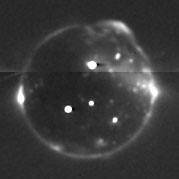Marduk (Io)
Coordinates: 29 ° 17 ′ S , 150 ° 16 ′ E

The Marduk is a volcano on the Jupiter moon Io . It was named in 1979 after the Sumerian deity Marduk . In that year, the Voyager 1 space probe first detected active volcanoes on Io. Marduk was identified as the source of an eruption column .
features
The volcano is considered to be very active. The surrounding region is considered a hotspot . It is often covered with dust. The ejected lava allows conclusions to be drawn about the inner structure of the moon and the forces acting on it, which are responsible for the seismic activities. During the flyby of the Galileo probe in 1996 it was evident that Marduk is a crevasse volcano about 250 km in length. From a caldera-like depression, lava flows northwards into about 200 km of extensive lava fields called Marduk Fluctus. The area around the volcano is reddish in color , presumably due to deposits of sulfur . During the eruptions, a lot of material is ejected, which cools down quickly in space. Presumably these particles are responsible for the red color of the neighboring moon Amalthea .
swell
- Portrait of the volcano on the Jet Propulsion Laboratory website. (English) accessed on July 20, 2018
- Short article about the volcano on the Jet Propulsion Laboratory website. (English) accessed on July 20, 2018
- Ashley Gerard Davies: Volcanism on Io . Cambridge University Press, p. 266 (English)
- Discovery of a Powerful, Transient, Explosive Thermal Event at Marduk Fluctus, Io, in Galileo NIMS Data . Geophysical Research Letters, accessed from the Lancaster University homepageon July 21, 2018
Web links
- Marduk in the Gazetteer of Planetary Nomenclature of the IAU (WGPSN) / USGS (English)
- Io: The Fissure King? - Astronomy Picture of the Day from November 29, 1996 (English).
- Overview photo with Marduk at gishbartimes.org
- Overview map with Marduk at solarviews.com
Individual evidence
- ↑ a b Davies, Ashley and Davies, RL and Veeder, GJ and de Kleer, K. and de Pater, I. and Johnson, TV and Wilson, Lionel: Discovery of a powerful, transient, explosive thermal event at Marduk Fluctus, Io , in Galileo NIMS data. In: Geophysical Research Letters , 45 (7). pp. 2926-2933. ISSN 0094-8276. April 24, 2018, accessed July 21, 2018 .
- ↑ Marduk Fluctus in the Gazetteer of Planetary Nomenclature of the IAU (WGPSN) / USGS (English)
